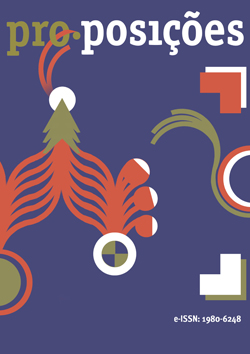Abstract
This article seeks to reflect on audiovisual technologies, digital platforms and artificial intelligence software aimed at personalizing teaching. The analysis addresses the use of algorithms for teacher evaluation, defense of educational technology companies, gamification as a strategy to encourage studies and the development of pedagogical proposals that prepare students for a market increasingly supported by automated and artificially “intelligent” operating systems. ”. At the end, it was sought to point out reconfigurations of the semiformation process in the beginning of the 21st century caused by the computational instrumentalization of education and the digital industrialization of culture.
References
Adorno, T. W. (1995). Educação para quê? In Educação e emancipação. (pp. 139- 154). São Paulo: Paz e Terra.
Adorno, T. W. (2009). A dialética negativa. Rio de Janeiro: Jorge Zahar.
Adorno, T. W. (2010). Teoria da semiformação. In B. Pucci, A. A. S. Zuin, & L. A. C. N. Lastória. Teoria crítica e inconformismo: novas perspectivas de pesquisa. (pp. 7-40). Campinas: Autores Associados.
Aoun, J. E. (2017). Robot-proof: higher education in the age of artificial intelligence. Cambridge, MA: MIT Press.
Berry, D. M. (2015). Critical theory and the digital. London: Bloomsbury.
Domingos, P. (2017). O algoritmo mestre: como a busca pelo algoritmo de machine learning definitivo recriará nosso mundo. São Paulo: Novatec.
Flusser, V. (2005). Para uma escola do futuro. Facom, 15, 4-7. Recuperado de: http://www.faap.br/revista_faap/revista_facom/facom_15/_flusser.pdf
Flusser, V. (2011). Pós-história: vinte instantâneos e um modo de usar. São Paulo: Annablume.
Gruschka, A. (2008). Escola, didática e indústria cultural. In F. A. Durão, A. Zuin, & A. F. Vaz. A indústria cultural hoje (pp. 173-183). São Paulo: Boitempo.
Lorenzoni, M. (2016). Gamificação: o que é e como pode transformar a aprendizagem. Recuperado de http://info.geekie.com.br/gamificacao
Lorenzoni, M. (2016). Geekie: o caminho para impactar 5 milhões de estudantes. Recuperado de http://info.geekie.com.br/geekie-5-milhoes
O’Neil, C. (2016). Weapons of math destruction: how big data increases inequality and threatens democracy. New York: Broadway Books.
Sadin, E. (2017). La humanidad aumentada: la administración digital del mundo. Buenos Aires: Caja Negra.
Tercek, R. (2015). Vaporized: solid strategies for success in a dematerialized world. Recuperado de https://vaporizedbook.com
Türcke, C. (2016). Hiperativos! Abaixo a cultura do déficit de atenção. Rio de Janeiro: Paz & Terra.
Türcke, C. (2010). Sociedade excitada: filosofia da sensação. Campinas: Editora da Unicamp.

This work is licensed under a Creative Commons Attribution-NonCommercial 4.0 International License.
Copyright (c) 2020 Pró-Posições


